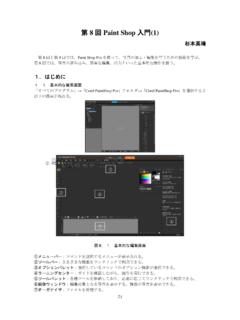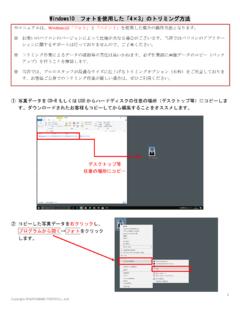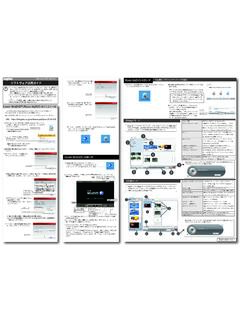Transcription of Corel PaintShop Pro 2022 Deployment Guide
1 Introduction As you read through this Guide , This Guide is intended to help you deploy Corel PaintShop Pro you'll find that the right column 2022 (Corporate and Education Edition) to your network as quickly of each page contains the main and easily as possible. content, while the left column contains the following categories Contents of information: Stage 1: Preparing for Deployment .. 2. definition explains the italicized term or concept Stage 2: Creating the server image .. 3. Stage 3: Installing the software .. 5. tip presents a helpful Stage 4: Maintaining the installations .. 15. detail, such as a shortcut, variation, or benefit Additional resources note presents an additional detail about the If you are new to software Deployment or otherwise require more specified topic or task basic information on deploying Corel software products, please refer to the Corel Beginner's Guide to Network Deployment .
2 You warning presents a can request a copy of this Guide from your Corel Support Services crucial detail about the representative. specified topic or task The left column also gives you For even more information, see the following Web resources. room to jot down notes. Web resource Description Corel website: Information about Corel Corporation and its portfolio of software products Corel Support Services Information about product features, website: specifications, pricing, availability, services, and technical support Corel Knowledge Base : A searchable repository of articles written by the Corel Support Services team For help with the Microsoft Windows Installer (MSI) technology that is used to install the software, please refer to the Microsoft website Deployment Guide Introduction 1.
3 Stage 1: Preparing for Deployment As used in this Guide , the To deploy the software to your network as smoothly as possible, term network signifies you can prepare by doing the following: two or more computers Check the system requirements for the software. that are connected to each other for the purpose of Prepare the server. exchanging information. Prepare the workstations. For details, see below. Checking the software requirements Workstations are the To begin, make sure that your server and workstations are eligible computers from which for the software. Consult the following: the average user works, Readme file or special instructions for the software (if available). and servers are the computers that manage the shared product-information page on the Corel website ( ).
4 Resources of the network. Preparing the server Make sure that the server meets the minimum system requirements for the software, and that it has enough free disk space for the installation. Make sure that the operating system (Windows 64-bit OS only). on the server has been updated with the latest service packs and security patches. Make sure that you have the proper permissions for creating a software image on the server. You must be either a local administrator or an administrator for the domain that you are managing, and you must have read/write access to the server location. Preparing the workstations Make sure that the workstations meet the minimum system requirements for the software, and that they have enough free To more easily manage disk space for the installation.
5 The access rights of Make sure that the operating systems (Windows 64-bit OS only). workstation users, you on the workstations have been updated with the latest service may want to use Group Policy packs and security patches. Objects (GPOs, or system Make sure that anyone who will be installing the software from policies ). See Managing the server image has the proper permissions to do so. To install permissions with Group Policy the software on a workstation, you must be either a local Objects on page 5. administrator or an administrator for the domain that you are managing, and you must have read access to the server location. Deployment Guide Stage 1: Preparing for Deployment 2. Stage 2: Creating the server image A server image, also called After preparing for Deployment , you're ready to create a server an administrator image image of the software, from which you can install the software to or simply an image, is a the workstations.
6 (If you want to support multiple installation set of uncompressed application types, you can even create multiple server images: one for each files on the server that is created desired configuration.). from a set of compressed files on the installation disc. Contents Creating a server image .. 3. Finalizing the server image .. 4. Creating a server image A command line is a textual To create a server image, you run a command line that initializes command that lets you the software setup and specifies your desired installation settings. specify desired settings. To run a command line 1 Open the Run dialog box (shortcut key: Windows Logo + R). 2 Type the command line in the Open box, and then click OK. To create a server image 1 Do one of the following: If you have an installation disc, insert the disc into the CD/DVD.
7 Drive. To mount an ISO file, If you downloaded an ISO file, mount the ISO to a directory or you might require third- extract the files from the ISO image to a directory on your party software that server by using a utility such as WinZip (available from helps you create a virtual drive. ). Alternatively, you can burn the If the AutoRun screen opens, click Exit. ISO file to a CD/DVD and access the files from the disc. 2 Run the following command line, where X: is the directory where the disc, ISO, or extracted files are located. X:\ /a 3 Type your user name and serial number (with or without hyphens) in the boxes provided, and then click Next. The customer information that you provide is passed on to the workstations when the software is deployed to the network.
8 By default, users can change the user name but not the serial number. 4 Specify a network location for the server image. To change the default location, type a valid server path in the Network location box, or click Browse to browse to a valid network location. Deployment Guide Stage 2: Creating the server image 3. 5 If you want to allow workstations to detect and download product updates, enable the Product updates check box. 6 Click Install to begin copying the files to the server. If you click Cancel, you are prompted to confirm that you want to cancel creating the server image. Cancelling rolls back the setup and undoes most of the changes made; however, some manual clean-up may be required. 7 Click Finish. You can also Create a server Use the following command line (where X: is the image silently directory where the disc, ISO, or extracted files are (or with limited located; image_location is the desired location of UI) the server image; and serial_number is the assigned serial number for the product): X:\ TARGETDIR="image_location".
9 SERIALNUMBER="serial_number" /q /a Proceed with extreme The /q switch is used to restrict the amount of the caution when using the user interface that appears during installation. For a /q switch to create a list of switch parameters, see page 8. server image. Create an error Use the following command line (where log_file log is the location and filename of the log file): X:\ /l "log_file" /a For a list of the parameters that are available for the /l switch, see page 8. Finalizing the server image To change the location of Before deploying from the server image, you may want to take the a server image, you must following steps. create a new image at the new location. You cannot copy Check for software updates an image from one location to another.
10 Check for software updates, and apply them to the image as necessary. This way, you can avoid having to deploy the software twice. For details, see page 16. Test the image Test the image with a small subset of workstations before rolling it out to your entire organization. Deployment Guide Stage 2: Creating the server image 4. Stage 3: Installing the software You can install the software on the workstations in two main ways: Looking for command- by having the users themselves install (or pull ) the software line switches and public from the server image to their workstations properties? See Pushing by using a command line to install (or push ) the software from the software on page 6. the server image to the workstations on the users' behalf Contents Pulling the software.
















